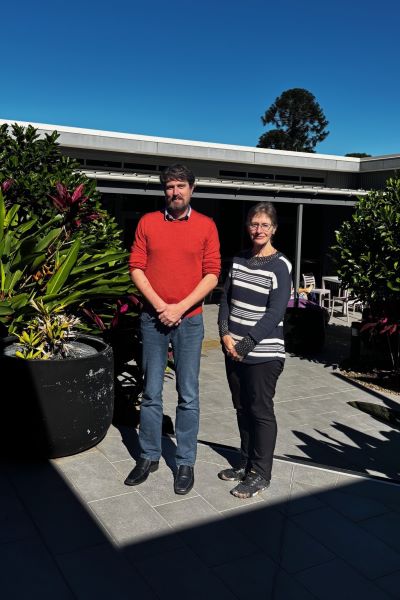Research project reducing suicidal ideation

Team Leader Sharon Gordon and fellow investigator David Ashmore at the Caboolture Youth Step Up Step Down.
A research project investigating intensive daily delivery of Dialectical Behaviour Therapy (DBT) for young people with suicidal ideation is showing some encouraging results.

Team Leader Sharon Gordon and fellow investigator David Ashmore at the Caboolture Youth Step Up Step Down.
The Metro North Youth Step Up Step Down (YSUSD) facility in the Caboolture CBD provides sub-acute residential mental health care for people aged 16–21 years of age.
The facility is run in partnership between Redcliffe-Caboolture Mental Health and non-government organisation Mind Australia. Most referrals are for young people who are suicidal and/or using self-harm as a way of coping, although most mental health diagnoses are accepted.
There is strong evidence to support that DBT reduces self-harm, suicidal ideation and improves overall functioning. DBT also shows promising results for managing depression and treating substance use, post-traumatic stress disorder and anxiety.
While DBT is usually a 12-month program delivered in the community, the usual length of stay (LOS) at the YSUSD is 14 days.
YSUSD Team Leader Sharon Gordon was keen to understand whether embedding DBT into a short, two-week timeframe in a sub-acute facility could deliver meaningful change for young clients.
“Two weeks of daily DBT skills groups were incorporating all elements of DBT for adolescents, inclusive of individual therapy and coaching,” Sharon said.
“Existing methods of DBT staff training — either face to face or online — were used with the addition of one modified, four-hour training devised for casual staff.
“The design was a pre-post quasi-experimental design with participants measured at three time points, pre, post and one-month follow-up.”
Measures used in the study were PGIS (Personal Growth Initiative Scale), SIDAS (Suicidal Ideation Attributes Scale), emergency department (ED) admissions from six months pre-admission to six-month post, and inpatient LOS six months pre to six months post-intervention.
“SIDAS scores from admission to discharge reduced significantly and were maintained at a one-month follow-up,” Sharon said.
“PGIS scores significantly increased from admission to discharge, dropped at the one-month follow-up, compared with discharge scores, however, remained significantly higher than baseline admission scores.
“Inpatient LOS was reduced across the intervention period, but the difference was not statistically significant.
“However, ED presentations significantly dropped from six-months pre to six-months post YSUSD, with the effect of the intervention resulting in 1.8 less ED admissions.”
Sharon said other youth mental health facilities (acute or sub-acute) could consider embedding a DBT program in their intervention to potentially reduce suicidality and ED presentations.
“We’ve found that embedding intensive DBT in a sub-acute program is a meaningful addition to suicide prevention treatment in adolescents,” Sharon said.
